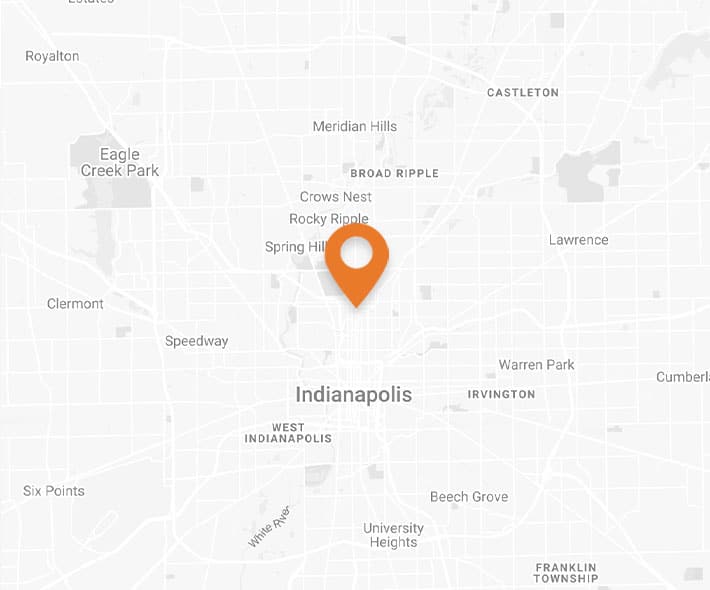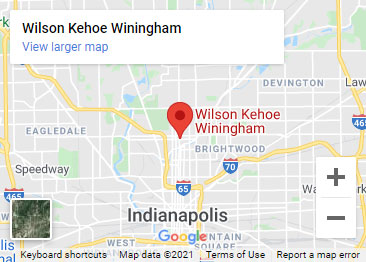Uninsured and Underinsured Motorist Coverage
Updated July 19, 2024 | By Wilson Kehoe Winingham staff
In many states, you’re legally required to have car insurance to drive on public roads. Most states also specify the minimum insurance coverage you must carry.
Uninsured motorist (UM) and underinsured motorist (UIM) coverage can be tricky to understand. Do I need underinsured motorist coverage? What’s the difference between UM and UIM coverage? Does Indiana require UM/UIM insurance coverage? What are the Indiana state minimums for UM/UIM coverage? How much UM/UIM coverage is actually enough?
This article will briefly cover various types of insurance coverage, review Indiana’s auto insurance requirements, and answer the question, “Do I need underinsured motorist coverage?”
Types of Auto Insurance Coverage
To understand how much uninsured and underinsured motorist coverage you need, you need to understand the basic types of insurance coverage. Not all types of coverage are required, and requirements vary from state to state.
Liability Insurance
Liability insurance covers you for damage that you cause in an accident. Nearly every state requires liability insurance.
This type of insurance falls into two categories—bodily injury and property insurance. If you are at fault in an accident, bodily injury liability insurance pays for injuries to other drivers and their passengers. Property damage liability insurance pays for damage to other drivers’ vehicles.
It’s typical to see liability insurance limits listed as three numbers separated by slashes—for example, $25,000/$50,000/$20,000. The first number is typically your per-person bodily injury liability limit. The second number is typically your per-accident bodily injury liability limit, and the third is your per-accident property damage liability limit.
Most states have minimum liability insurance requirements. As long as you have the minimum amount of coverage, it’s legal for you to drive. However, the minimum coverage may not and often does not protect your personal assets if you get sued for causing a car accident.
For example, suppose you have $25,000 in property damage liability coverage, and you rear-end another driver. The other driver’s new car, worth $50,000, is totaled. Your insurance will only cover half of this amount, so you will need to make up the difference out of your own pocket, an additional $25,000.
Uninsured and Underinsured Motorist Coverage
Uninsured and underinsured motorist insurance also includes the two coverage categories of bodily injury and property damage. UM/UIM insurance pays for your medical expenses and/or damage to your property when a driver with no insurance or inadequate insurance causes an accident. It insures you against other drivers’ negligence and their failure to maintain adequate liability insurance. About half of all states require this type of coverage.
Suppose an uninsured driver runs a red light and hits your car. With UM coverage of $25,000/$50,000/$25,000, you and your passengers are covered for injuries and damage to your car up to these limits. UM coverage also pays for injuries and property damage if you are the victim of a hit-and-run car accident.
Underinsured motorist coverage is similar but a little bit more complicated. Suppose a driver with $25,000/$50,000/$25,000 liability insurance causes an accident in which you are injured. Your medical expenses are $50,000. The other driver’s insurance will only pay half of your medical expenses, up to their $25,000 limit.
If you have UIM coverage with the same limits—$25,000/$50,000/$25,000—the coverage does not kick in because your coverage is the same as the other driver’s coverage.
If you have UIM coverage with $50,000/$100,000/$50,000 limits, your UIM insurance would cover the remainder of your medical expenses, up to your $50,000 per-person bodily injury UIM limit.
Personal Injury Protection and Medical Payments Coverage
Personal injury protection (PIP) is required in states with no-fault insurance laws. In a state with at-fault insurance laws, the at-fault driver’s insurance company pays for the other party’s medical expenses. In a no-fault insurance state, each driver’s PIP insurance pays for medical expenses.
Medical payments coverage pays for medical expenses resulting from a car accident for you and your passengers regardless of fault. This is usually optional coverage in at-fault insurance states. Suppose you don’t have health insurance or you have health insurance with a high deductible. In that case, medical payments coverage protects you from paying the cost of medical bills for you and your passengers if you are at fault in an accident.
Comprehensive and Collision
Comprehensive and collision are two types of optional insurance coverage.
Comprehensive pays for damage to your vehicle if it is damaged by fire, flood, or hail, if you hit a deer while driving, or if your car is vandalized or stolen.
Collision pays for damage to your vehicle when you collide with something, regardless of fault. This includes a collision with another vehicle, a wall, a tree, or a telephone pole.
Both comprehensive and collision coverage usually have a deductible. The coverage kicks in after you pay the deductible amount. For example, suppose a freak hailstorm breaks your windshield and damages the hood of your car. You have comprehensive coverage with a $500 deductible. The cost of repairs is $1,000. You pay the first $500 (your deductible), and your comprehensive coverage pays the remaining $500.
Indiana Insurance Requirements
Each state stipulates its own financial responsibility requirements for drivers. Indiana’s requirements are as follows:
- Bodily injury liability insurance of $25,000 per person
- Bodily injury liability insurance of $50,000 per accident
- Property damage liability insurance of $25,000 per accident
- Uninsured motorist coverage that matches the minimum liability insurance amounts
- Underinsured motorist coverage of $50,000 for bodily injury
Indiana requires that all insurers offer UM/UIM coverage in the amounts specified above. If you do not want UM/UIM coverage, you must sign a waiver rejecting it. This means that even if you’ve never heard of UM/UIM coverage before, you probably already have it.
So, we’ve answered the question, “Is uninsured/underinsured motorist coverage required in Indiana?”—it’s required unless you explicitly reject it. But a few questions remain:
- Do I need uninsured motorist coverage?
- Do I need underinsured motorist coverage?
- How much uninsured and underinsured coverage do I need?
You Need More UM/UIM Coverage than You Think
Not only is it wise to carry UM/UIM coverage, you probably need more UM/UIM coverage than you think. The Insurance Research Council reports that in 2019, 12.6% of all drivers were uninsured. In Indiana, the percentage was even higher: 15.8%. That means that if you get into a car accident in Indiana, there’s a 1 in 6 chance that the other driver won’t have car insurance. UM/UIM coverage is especially important for this reason – it allows you to decide how much protection you have if someone else causes an accident.
FAQ
Do I Need Uninsured Motorist Coverage?
Perhaps you’re still wondering, “Should I have uninsured motorist coverage?” Consider this: If you suffer injuries and/or property damage in a car accident caused by an uninsured driver and you don’t have UM coverage, you’ll need to pay for your own medical expenses and car repairs.
There are a couple of exceptions to this. First, with medical payments coverage, you can file a claim for your injuries in an accident caused by an uninsured driver. However, medical payments coverage is significantly more expensive than UM/UIM coverage. Second, with collision coverage, you can file a claim for damage to your car in a collision with an uninsured driver. However, (1) you must pay your deductible before collision coverage kicks in, and (2) collision coverage only applies to your vehicle.
Do I Need Underinsured Motorist Coverage?
If you’re still questioning whether underinsured motorist coverage is worth it, consider the following example.
A driver with Indiana state minimum insurance coverage hits you from behind, injuring you and a passenger and totaling your car.
Medical expenses for you and your passenger exceed the other driver’s $50,000 state-minimum bodily injury policy. But you have UIM bodily injury coverage of $100,000. Your UIM coverage pays for medical expenses for you and your passenger that exceed the other driver’s $50,000 limit up to your UIM limit of $100,000.
This is particularly important if you don’t have health insurance, your passenger doesn’t have health insurance, or you have health insurance with a high deductible.
How Much UM/UIM Coverage Do I Need?
It’s smart to base your auto insurance liability coverage on your net worth to protect your assets if you cause an accident. But when it comes to UM/UIM coverage, it’s tempting to think that you can make do with less.
It’s a good idea to have your uninsured motorist coverage mirror what you carry in liability insurance. In other words, if your liability coverage is $50,000/$100,000/$50,000, you should consider carrying $50,000/$100,000 in UM bodily injury coverage. Make sure your UM property damage coverage mirrors your car’s value so you can replace your car if it’s totaled.
Underinsured motorist coverage kicks in once the at-fault driver’s insurance has paid the full amount of the driver’s liability policy. This means that if your bodily injury UIM coverage amount (for example, $50,000) is the same as the other driver’s bodily injury liability limit (also $50,000), your UIM coverage does not apply. Therefore, if you want the peace of mind that UIM coverage offers, it’s wise to get more than the Indiana state minimum in UIM coverage.
At WKW, one of the biggest problems our clients face is there is not enough insurance coverage to fully compensate them for their injuries because the at-fault driver has inadequate liability insurance and our client has inadequate UM/UIM coverage. Because of this, we recommend people purchase an abundance of UM/UIM coverage.
How Much Does UM/UIM Coverage Cost?
Uninsured and underinsured motorist coverage is usually sold as two separate products. You can expect to pay between $50 and $100 annually for UM coverage and a similar amount for UIM coverage. This is likely a reasonable price to pay for the peace of mind that comes with knowing you’re covered in the 16% of Indiana accidents involving uninsured drivers.
Contact an Experienced Indianapolis Car Accident Lawyer
Even if you have all the right insurance coverage, it’s important to know what to do after a car accident. Managing the aftermath of a car accident is both complicated and stressful. This is even more true in accidents involving uninsured and underinsured drivers. If you’ve been in a car accident, the experienced Indianapolis car accident attorneys at Wilson Kehoe Winingham can help you through this difficult time. Call 317.920.6400 or fill out an online contact form for a free, no-obligation case evaluation.
Contact Us
Let WKW put our experience to work for you. Contact us for your free case evaluation.
Or, call us today at (317) 920-6400


